| If you really want to insult somebody in the computer
industry, accuse that person of thinking like a stodgy
data-processing manager from the dinosaur days of big
iron. It's a well-worn weapon that both sides are wielding
in the debate over personal computers versus network
computers (NCs). But which side is most guilty of mainframe mentality? The answer is not as obvious as it may seem. Intel and Microsoft, leading the charge against NCs, say the new devices are nothing more than throwbacks to the bad old days of centralized computing and dumb terminals. NCs will limit your options and steal your freedom, they argue. IBM, Oracle, Sun, and others claim it's the Wintel empire that's old-fashioned. NCs will cut costs and simplify your life, proponents insist. And they point out that the arguments against NCs sound an awful lot like the discredited arguments against PCs — that simpler, less expensive computers just can't do anything useful. Here's the truth: PCs and NCs are not an either-or choice. And neither type of machine is a one-size-fits-all solution. There's room for both in almost any organization. Contrary to what you may have heard, it's possible for a company to adopt NCs without smashing all its PCs with hammers and rewriting all its software in Java. PCs and NCs can peacefully coexist on the same networks, access the same data, and, in some cases, even run the same software. Open-minded MIS managers can save money and boost productivity by matching the appropriate computing device — PC or NC — to each worker's job and skills. This month we'll describe how the technical efficiencies and cost savings of NCs can reduce computing maintenance and administrative costs for some IS operations. Next month we'll focus on what some people view as the less radical approach: finding ways to cut operational overhead for the typical networked PCs that are commonplace in businesses today. Both strategies offer strengths and weaknesses; to use either effectively, companies must make choices based on a clear technical understanding of each alternative. What's an NC? Something obscured by the debate is that all NCs are not the same. Some are radical new devices designed to run software written in Java, albeit with gateways to existing programs and data. These are the official Network Computers (an Oracle trademark) and JavaStations (a Sun trademark) supported by an alliance of like-minded vendors. But there's a whole other class of machines that are true terminals in the classic sense: Unlike NCs, they don't execute programs on the desktop. Instead, applications run remotely on a multiuser server, and the client machine handles only the graphics locally. These machines offer a more conservative approach than true NCs because they're designed to run Windows and other popular software — albeit remotely — rather than requiring new Java software. The applications run on a server, not on the desktop, which is why these machines are technically terminals, not computers. But they're not underpowered dumb terminals. Although they cost less to buy and support than a PC, they can actually run PC software as well as a PC can. The generic term for these and the NC alternatives to the PC is thin client (see the figure "Thin and Fat Clients"). They're referred to as "thin" because they're generally less complex and less expensive than a PC. It's not a sexy name, to be sure, but we seem to be stuck with it. Whether they represent a new paradigm or an updated twist on an old one, all thin clients have three things in common: They cost a little less to buy than a typical PC (though rarely as little as the magical $500 figure when configured for business); they cost less to support than a typical PC (5 percent to 40 percent less, according to industry analysts); and they're "stateless" machines that rely on servers to store all volatile data and software (except for stuff temporarily cached in RAM or on disk). In other words, thin clients are primarily designed to save administrative costs over the long haul, and they're interchangeable parts that are easy to replace when broken because they don't store information persistently. Thin clients won't make PCs obsolete any more than PCs made mainframes obsolete. They're just one more computing option. "We tend to think mainframes were defeated by minicomputers, minis were defeated by PCs, and maybe PCs will be defeated by network computers," says John McCrea, a marketing manager at Silicon Graphics, Inc. (SGI). "But the topology of computing is actually very diverse. We've still got mainframes, we've still got minis, and we'll always have PCs. That diversity isn't going away, and I believe the topology will become even more diverse in the future." Still, many people are skeptical. A recent survey done by market researcher Computer Intelligence of 319 technology decision-makers at large U.S. companies found that 42 percent of them had no plans to evaluate or adopt NCs in the next year. However, 51 percent of those same respondents were not familiar with NCs. Thin clients aren't a pipe dream. In January, Sears agreed to buy 2500 machines from Boundless Technologies to replace PCs on token-ring networks in stores throughout the U.S. In December, AT&T announced it would spend $5.3 million on Boundless machines for its call centers. Barclay's Bank is using 15,000 thin clients made by Network Computing Devices (NCD); Federal Express has 10,000 thin clients, and the University of Washington has more than 1000. FTD is recommending the purchase of 17,000 Sun JavaStations to replace old PCs at florist shops nationwide. These and other companies are discovering that thin clients can save them money, too; see the sidebar "Thin Clients: Behind the Numbers". Intel and Microsoft take thin clients very seriously. Their initial reaction to the NC hype was to respond with a bar-rage of counter-hype (see the sidebar "10 Myths About Thin Clients"). Now they are striving to make PCs less costly to manage. Microsoft's Zero Administration for Windows (ZAW) and Intel's Wired for Management are two initiatives that address some of the criticisms leveled at PCs. They're also defining a diskless PC standard, called the NetPC, that's not as thin as a thin client, but not as fat as a PC (see the sidebar "The Wintel Empire Fights Back"). Even if your company never buys an NC, you'll benefit from the changes NCs will bring to PCs. Deployment Decisions The key to saving money with thin clients is knowing when to use them. Even the most rabid advocates don't suggest that thin clients will completely replace PCs for all purposes. Thin clients work best in the following situations. When users work with a limited set of programs. Such users might range from low-level order-entry clerks to top-level executives. The key factor is that these users rarely need new applications, because thin clients normally don't let users install software that's not available on the server. Shared desktops. The old business model of full-time employees and one person per office is giving way to a workplace with part-time employees, independent contractors, temporary workers, and telecommuters. It makes little sense to reserve a full-blown PC for everyone who might need occasional use of a computer at the office. Because thin clients are stateless, employees can share them and enjoy their own personalized working environment after logging on. And that same environment is available to them at home or on the road. Remote users who are difficult to support. If a PC breaks down at a remote location, MIS must either send someone to fix the problem or talk the user through the repairs. Because thin clients lack extras such as persistent storage, there's less to go wrong with them. With a true hardware failure, MIS can easily replace a stateless client with a new machine because there's no local software or data files to restore. Jobs that revolve around remote data instead of local data. An order-entry person who spends the day checking data in a centralized database and filling in electronic forms is well served by a simple, foolproof machine. So is a factory foreman who needs to view the latest engineering drawings in a database. These jobs are highly specific and network-centric, so the workers aren't sacrificing flexibility by switching to a network-centric device. Whenever security is paramount. Conventional desktop and laptop PCs can be security nightmares because they store everything locally and users have virtually unrestricted access to local storage. Every loss, theft, virus attack, breakdown, or break-in is potentially catastrophic if it endangers strategic data. Thin clients that store everything on a server are generally safer because server closets are more physically secure and professionals regularly back up the servers. The only caveat is that network-centric clients might be more vulnerable to network snooping — but networked PCs aren't immune to that, either. Replacements for older, text-based terminals. Analysts estimate there are 30 million to 50 million dumb terminals installed worldwide. These include IBM 3270 and 5250 terminals, VT-series terminals, and similar ASCII/ANSI devices. Today's thin clients can use the same legacy programs and data that these dumb terminals use, yet they provide a GUI, as well as access to the Internet and corporate intranets. Thus, as more business resources (e.g., e-mail, company directories, and internal discussion groups) migrate to intranets, and as more enterprises deploy applications on new platforms, such as Windows NT, thin clients allow more possibilities than dedicated terminals. "Intranets are becoming a vital part of the corporate infrastructure," notes Dave Folger, an analyst with the Meta Group. On the flip side, thin clients are not well suited for users who need lots of local processing power, who frequently need to install new software, who use a variety of peripherals, or who don't have access to a network that's fast enough to run network-centric applications. For example, a graphic artist who uses Adobe Photoshop to scan and edit artwork needs a powerful PC. Software developers who frequently install new programming tools and utilities need more local control over their systems. Telecommuters who rely on slow dial-up connections may or may not be able to get by with an NC, depending on the types of applications they're running. For reasons that are both technical and psychological, many users who have a choice will always prefer a PC. However, as the technology continues to advance, and as computers penetrate deeper into organizations, the percentage of users who absolutely must have a PC will decrease. The first people who got PCs tended to be knowledge workers — users who organize or create information. As PCs became more pervasive, they appeared on the desks of workers who need to merely access information or perform other nonstrenuous computer tasks, such as using e-mail. Many of those tasks require a network, but not an expensive PC. That's why it's not going out on a limb to predict a fat future for thin clients. Anorexic Clients The thinnest clients of all are terminals that handle the graphics display locally for programs that execute remotely on a multiuser server. Technically, they're not dumb terminals because dumb terminals are just keyboards and screens wired up to a central computer; they don't process graphics locally, and they're not on a LAN. Nevertheless, these graphics terminals are certainly "dumber" than PCs. (In fact, they're also dumber than NCs, which execute programs locally.) X Window System terminals are a prime example. They offer the advantages of a thin client — lower acquisition and support costs and stateless operation — without the more radical commitment to Java implicit in the Oracle/Sun NCs. For this reason, terminals might be easier to integrate with existing environments. Some people associate these terminals exclusively with X and Unix, concluding they're not an option for corporate environments based on Microsoft Windows. It's an understandable assumption because Microsoft doesn't sell a multiuser OS comparable to Unix. Microsoft's flagship OS, Windows NT, is a multitasking and multiprocessing OS, but it's not a multiuser OS. However, there's a multiuser version of NT available from a third party: Citrix Systems. Citrix is a relatively small company that enjoys an unusual relationship with Microsoft. Microsoft owns a piece of Citrix and sits on Citrix's board of directors. More important, Microsoft has granted Citrix a source-code license and a distribution license for Windows NT Server. Nobody else has such a license. It allows Citrix to modify NT, resell it to customers, and sublicense it to other companies. Citrix has used this license to create a multiuser version of NT Server known as WinFrame, which Citrix's sublicensees modify. So, while Microsoft denounces NCs in public, it supports even thinner clients than those championed by Oracle and Sun (see the sidebar "Windows Everywhere, Thanks to Citrix"). The key difference from Microsoft's view is that WinFrame terminals are primarily designed to run Windows programs, while NCs are primarily designed to run Java programs. Microsoft embraces Java as a development language but ab-hors it as a platform. WinFrame delivers Windows software to many different platforms — including non-PC platforms, such as thin clients — while defending Windows as the dominant OS. Java, as a platform, potentially threatens that dominance (see "Today the Web, Tomorrow the World," January BYTE). Java-Centric NCs Of course, most of the hype about thin clients originated from Oracle and Sun, who are pushing the concept of NCs that run Java. Programs written in Java can execute without recompiling on any platform that has a Java run-time environment. Oracle's NC standard doesn't prohibit NCs from also running native software, such as Windows, but it's definitely oriented toward Java. In this sense, Oracle and Sun are taking a more radical approach because they are betting on the success of Java as a universal platform. In another sense, NCs are less radical than graphics terminals connected to multiuser servers. Java programs execute on the desktop, not on a server, so NCs are real computers, not terminals. While it's true that Java programs often arrive over a network from a server, there is nothing revolutionary about networks and applications servers. Also, NCs fit into the two- and three-tiered client/server models: Users can manipulate centralized data with a Java program directly from their desktops or through a middle-tier server that's exposing a server-side application to a Java applet. Nothing revolutionary there, either. The great advantage of Java-centric NCs — in addition to the usual advantages of thin clients — is that Java programs are decoupled from the OS and CPU. Everything below the Java virtual machine (VM) can change without breaking applications (see the figure "The Java Platform"). That gives users and NC vendors unprecedented freedom to adopt whatever OS or CPU is their best option. The disadvantage of Java-centric NCs is that some designs require new software written in Java. But NCs don't burn all bridges behind them. Numerous gateways to existing databases and applications are popping up. Java programs can already access just about any database through Java Database Connectivity (JDBC) drivers and middleware, such as Symantec's dbAnywhere and The Santa Cruz Operation's (SCO's) SQL Retriever IV. More amazing are the new Java gateways to non-Java software, including programs written for Windows, Unix, X, and mainframes. Three examples are TriTeal's SoftNC, SCO's Tarantella, and Insignia's NTrigue Client for Java. All use Java to impersonate an X terminal or even a text-based dumb terminal on an NC. The Java programs link to server-side components, which in turn run a non-Java program on a server or a mainframe. It sounds impossible, but you'll soon be able to run Windows, mainframe applications, or just about anything else on a Java-centric NC over a network. Because the non-Java program executes on the server or mainframe, it performs at native server speeds, although prerelease versions of the Java gateways are noticeably slow at redrawing the screen. SoftNC is a complete desktop environment written in Java that can mimic the look of Windows 95, Motif, or the Unix Common Desktop Environment. By using various Java programs, SoftNC provides portals to Windows, Unix, 3270, and 5250 applications. Fujitsu, NCD, and Wyse all license SoftNC for their thin clients. The first release of Tarantella (scheduled for the first half of this year) will run Unix character-based programs and X graphics programs on NCs. A follow-up version of this Java applet will add support for IBM 3270 and 5250. The third release, due by September, will run Windows (see the figure "Multiplatform Tarantella"). Insignia's Java applet, which runs only Windows, is also slated for release in the first half of this year. It will be bundled with Sun JavaStations. It's less than 100 KB in size and uses an optimized version of X that strips out all the graphics calls duplicated in Java's Abstract Windowing Toolkit (AWT), the class library that provides GUI services to Java. During one demo, an Insignia engineer launched Sun's HotJava browser on a JavaStation and ran the NTrigue Java applet inside the browser (see the screen). This opened a gateway to an NT server, on which he ran Excel. Then he launched the Windows version of Netscape Navigator. Now he had a browser running within a browser (HotJava running locally on the NC, and Navigator running remotely on the server). Using Navigator, he ran another instance of the NTrigue Java applet, which in turn opened a gateway to another instance of Windows. And so on. One point of this impressive demo is that recursion is hypnotic. Another is that Java-centric NCs can mesh with existing environments wherever they make sense. They won't force anyone to rewrite all their software in Java or ditch their PCs. NCs merely expand the client model — they don't change the client/server, network, or enterprise models. Science vs. Superstition Confusion abounds over what exactly constitutes an Oracle-standard NC. Oracle's NC Reference Profile is explicit, but it also casts a broad net. Most PCs (including Microsoft's proposed NetPC) meet the Oracle NC standard if they've got a Web browser, Eudora, and a Java run-time environment (see "Inside the NC," November 1996 BYTE). Microsoft rips NCs because they don't standardize on a single OS or CPU. Some critics trash NCs as stripped-down PCs. Others believe NCs can't have hard drives and work only with TVs. Still others are fixated on the widely quoted $500 price tag, declaring that any NC costing a penny more is a phony. Microsoft warns that NCs will force developers to use Java. Some critics are victims of misinformation; others just don't get it. First, the deliberate lack of an OS or CPU standard is a huge advantage: The OS and CPU barely matter because Java abstracts everything below the VM. While 90 percent of PC users are locked into a single-source vendor for their OS and CPU, NC vendors can swap those parts anytime without breaking software. Users don't have to worry about the inner workings of their NC any more than they have to worry about what's inside their cellular phone or VCR. Second, NCs are stripped-down PCs in the same way that PCs are stripped-down minicomputers and that minis are stripped-down mainframes. In other words, that's the point. But thinner doesn't always mean slower. NCs with StrongARM processors, which can attain 233 MIPS, outrun all but the fastest PCs at a fraction of the cost. NCs can have hard drives, and they work with standard video monitors. Some NCs (especially those for the consumer market) actually cost $500 or less. NCs for the business market — designed to cut long-term administration costs, not just acquisition costs — typically cost around $1000. Finally, we've already seen how organizations can integrate NCs without abandoning PCs and rewriting everything in Java. Java's cross-platform compatibility is compelling, but it requires developers to learn Java. Or does it? The Java VM is a platform implemented in software, and Java bytecode is the native instruction set for that platform. Compilers for other languages can target bytecode, just as they target any other instruction set. It's already been done: Intermetrics has an Ada compiler that produces Java bytecode. Parc Place/DigiTalk has experimented with a Smalltalk-to-bytecode compiler. Theoretically, a C++ compiler could do the same. James Gosling, who led the development team at Sun that invented Java, thinks Microsoft's Visual Basic could even output bytecode. (That probably won't happen, but for reasons that are more political than technical.) NC Trends In 1995, Oracle promised that NCs would ship by fall 1996. Oracle's prophecy came true — thanks to enterprising vendors who created their own designs. Last September, HDS Network Systems began shipping the @workStation, a hybrid X terminal and Oracle-compliant NC. Prices start at $749 for an Intel 960-based system with 8 MB of RAM. In December, Sun began shipping the JavaStation at a base price of $742 with 8 MB of RAM and a MicroSparc II processor. And early this year, Wyse began shipping the Winterm 4000, with a StrongARM processor and 8 MB of RAM, for $750. Although these machines comply with Oracle's NC Reference Profile, they're not based on Oracle's hardware reference design. The NC Reference Profile merely defines the minimum requirements for an NC, while the hardware reference design is a complete motherboard that a manufacturer can license and copy. Acorn produced Oracle's first reference design using the ARM 7500FE, a highly integrated chip that includes a CPU; I/O, memory, and video controllers; and audio functions. This NC has been in production since last August, but only in small numbers for trial purposes. Several trials are under way, particularly with Internet service providers (ISPs) who want to bundle NCs with Internet access for a flat-rate monthly charge. One such ISP is NetChannel. It's working with NChannel, a U.K. company that began mass-producing NCs early this year. Three Designs Oracle's spin-off company, NCI, is licensing the ARM 7500FE design to other manufacturers. Licensees announced so far include Akai, Funai, Idea (a vendor of IBM-compatible terminals), Proton, RCA, Uniden, and Zenith. Digital Equipment is producing a second reference design (i.e., a second motherboard design that manufacturers can license and copy) based on the 200-MHz StrongARM SA-110 processor, jointly developed by ARM and Digital. A third reference design will use Intel's Pentium-100. Features vary depending on the intended market, but all NCI-licensed designs are similar. They typically have 4 to 64 MB of RAM, an 8-MB ROM card, a SmartCard slot, infrared and network interfaces, a parallel port, and a pair of PS/2-compatible I/O ports for connecting a mouse and keyboard. The SmartCard slot allows multiple users to share an NC by storing their profiles on a SmartCard; it also offers interesting possibilities for on-line commerce by enabling secure electronic transactions. The infrared port is for wireless remote controls and joysticks. The network interface supports Ethernet, asynchronous transfer mode (ATM), ISDN, or a modem. The parallel port works with built-in drivers for popular printers and Iomega Zip drives. (Users can download additional drivers if necessary.) The ROM card holds Oracle's NCOS (a multitasking OS based on Acorn's RISC-OS for ARM), a Web browser, a word processor that saves files in Word format, a Java run-time environment, a MacroMedia Shockwave player, and a MIDI synthesizer. Users can update the software by downloading patches into RAM or by swapping ROM cards. Hard drives are optional and are always used for caching; users store their files on a server. The only exception to this rule is that a mobile NC would temporarily store data files (and some software) on disk between network sessions. A mobile NC must store some state between network connections. But that volatile state is immediately uploaded to the server the next time you connect to a network. Mainframe Mentality NCs will succeed if they can overcome all the prejudice. Their biggest obstacle is the tired argument that a simpler computer can't do some of the work that a more complex computer can do. It's been disproved again and again as computers have downsized from mainframes to minicomputers to PCs. NCs are simply the next logical step in the computer evolution that's been going on for half a century. Of all the arguments against NCs, the only one that holds water is that NCs are more dependent on networks than PCs are. They are, after all, network-centric computers; there's no doubt that NCs work better on fast networks and that network outages can bring NCs to a screeching halt. But PCs are becoming more network-centric, too. More to the point, applications are becoming more network-centric. If a task relies on access to a centralized database, a client/server application, an intranet, or the Internet, it doesn't matter whether the client is an NC or a PC. A network outage will idle either kind of machine. With a graphics terminal, you can't work when the network is down, but with an NC you can still run programs locally. Dependence on networks is nothing new. Businesses already depend on electrical networks, PBX networks, public telephone networks, and transportation networks. Computer networks are just one more infrastructure that businesses must rely on skilled professionals to maintain. Most curious is the desire to standardize on one OS and one CPU architecture. Depending on a single company for all future OS innovation and on another for all future CPU innovation would be tragic for an industry driven by technology. There's room in the world for all kinds of computers: supercomputers, minicomputers, mainframes, PCs, laptops, hand-helds, game machines, you name it. NCs will find their place, too. Sidebars:
Where to Find
Acorn Computer Group plc
Six Ways to Use Thin Clients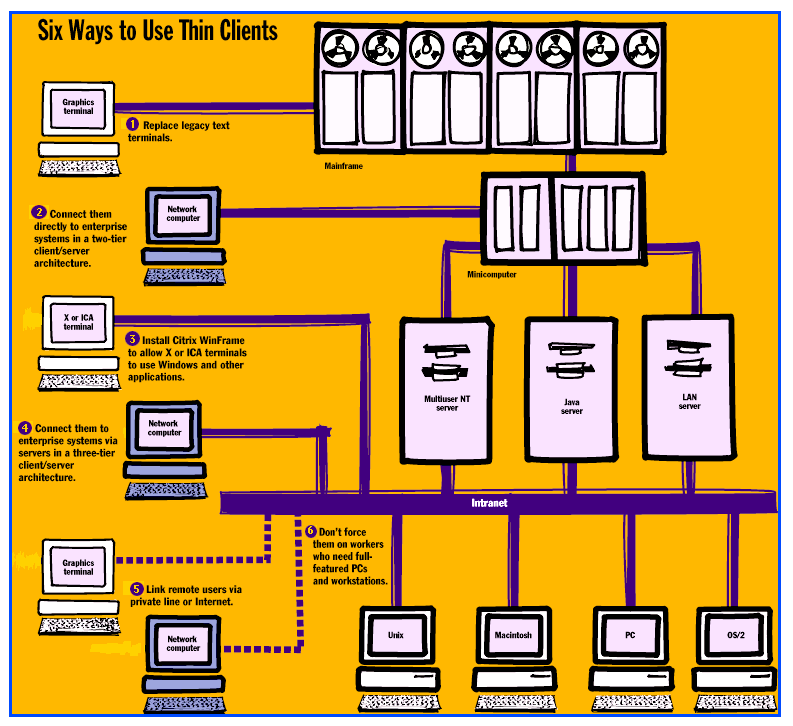 The Java Platform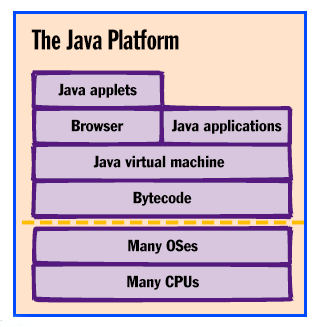 Java abstracts everything below the dotted
line.
Multiplatform Tarantella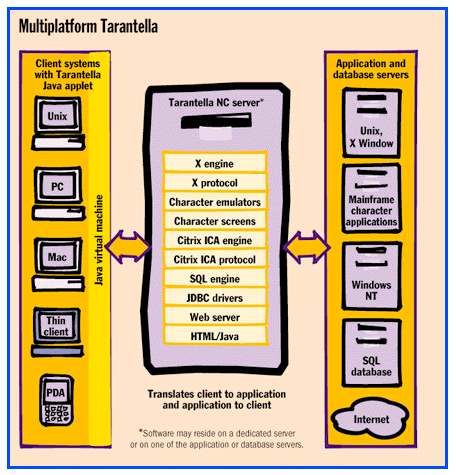 Any client system with SCO's Tarantella Java
applet will use applications from multiple platforms.
Thin and Fat Clients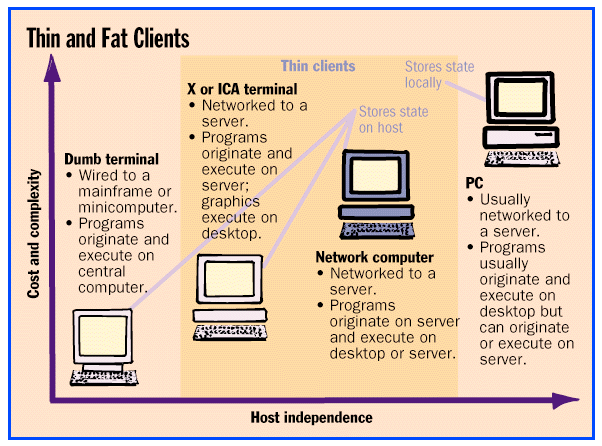 Client systems range from dumb terminals to
mostly autonomous PCs. Thin clients fall in between.
Akai's Internet Connection N/C (rear view).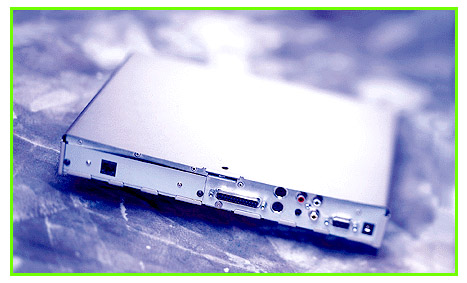 Five Thin Clients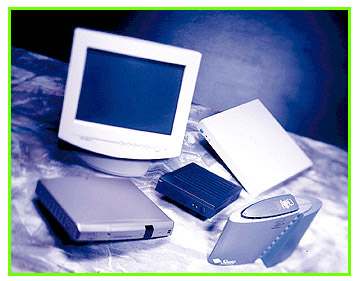 Two NT Choices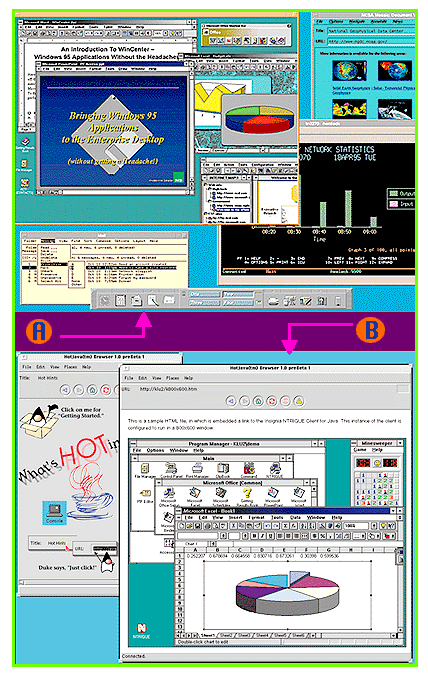 A: NCD's WinCenter runs applications on an NT server and converts user-interface requests into X Window System calls... B: ...and Insignia's NTrigue Client for Java is an applet that allows NCs to use Windows NT applications. Tom R. Halfhill is a BYTE senior editor based in San Mateo, California. You can reach him at thalfhill@bix.com. Inbox / April 1997We've Been Here BeforeNet PCs are neither new nor are they going to become popular in the foreseeable future. My reservations stem from my work with X stations under Unix. So-called diskless workstations have been manufactured for years. While they are useful in some narrowly defined instances, for the most part, the network load they represent is unacceptable, especially when they're used for general-purpose computing. Think about it: The average hard drive has a potential transfer rate of hundreds of millions of bits per second and latencies measured in the sub-10-millisecond range. Popular software is based on the assumption that this bandwidth is available. Ethernet has a base transmission bandwidth of tens of millions of bits per second and latencies in the best case of tens of milliseconds — 1000 times slower. Also, it must be shared among all users on the network. Until we have a network access system that is at least two orders of magnitude faster, NCs simply won't have the performance the average user expects. Steve Booth bcs@cerf.net X terminals and their close cousins, ICA terminals for Citrix multiuser Windows NT, load and execute applications on the host; only screen graphics execute on the desktop. Oracle-standard NCs, on the other hand, do load applications over a network and execute them locally. However, NCs won't necessarily suffer from the problem you describe, either. For one thing, they'll often find their niche in client/server environments where the client-side application is relatively small. Second, desktop applications written as components in object-oriented languages such as Java don't have to load megabytes of code into memory all at once. Parts of the program can load only when needed. Finally, NCs can optionally cache programs on local hard drives or in RAM. I've seen some prototype NCs that trickle power to RAM even when switched off. When you switch them back on, they come to life instantly, and your previously loaded programs are waiting for you. — Tom R. Halfhill, senior editor Inbox / July 1997Definitive ArticleThanks for what must be the definitive article on network computers (NCs) ("Cheaper Computing," April). I found Tom R. Halfhill's unbiased coverage to be both broad and sufficiently deep to give an excellent understanding of what's currently happening and what's going to happen with the NC market. Leigh S. Power powerl@guinness3.team400.ie Real Statistics "Cheaper Computing" was an excellent tutorial on the NC-versus-PC debates. In it, Tom R. Halfhill says that the only argument against the NC that holds water is its network dependency. I have just run a detailed analysis of 805 help-desk calls for one day's worth of activity on an exceedingly well-run network. Only four of those calls could be classified as "communications" failures. The rest were mostly operator errors (such as failed log-ons, printers that didn't work, and wires that got kicked). I wonder whether you have access to statistics about what really happens on networks. It's not the technology that costs; it's people. Paul Strassmann paul@strassmann.com If by "communications failures" you mean network problems, and if your results are typical for most networks, then the argument that NCs are too network dependent may not be such a good one. Besides, as I said in the story, applications are becoming network-centric, so PCs are not immune to network problems, either. Another way to look at it is that NCs are not the cause of network dependency; rather, increased network-centricity is causing NCs. Statistics aside, I think the biggest problem with today's PCs is persistent storage, especially the intermingling of system software, applications software, and user files on the same storage device. When you consider that users are not only allowed, but often required, to tinker with their system software — and that any program's installer can also modify the system software — it's a wonder PCs work at all. NCs, as stateless devices, avoid the problems associated with persistent storage. Over time, I think PCs will address this issue more directly. —Tom R. Halfhill, senior editor Inbox / August 1997The Nonexistent NCAfter reading everything I could find on network computers (NCs), I have come to several conclusions: • The $500 NC does not exist. If and when it is deployed, it will be of limited use, especially in the business community. • Machines useful in the business environment will cost about $1200 to $1500. There will be no significant savings in the hardware investment. • There are potential savings in administration and maintenance, but the hidden costs of creating the support systems are not yet clearly understood. • The savings most quickly realized will be in centralized administration. Version control of the installed software base will become simpler. (Current products provide all or parts of the solution to software distribution and version control.) • The end user must surrender much flexibility. Some types of customization will be difficult, and installation of unauthorized software will become a political issue. • Many applications might have to be rewritten. Custom client/server applications might not be supportable on some types of NCs. • While the NC concept is fascinating, it is not truly viable for the business user at present. Bruce E. Golightly Principal Software Engineer Carnegie Mellon University bg0l@andrew.cmu.edu I don't disagree with all your points, but I think you've overlooked a few things. Although reduced administration is considered to be the larger benefit, $1200 for a decked-out NC is about half the average price now paid by corporations for a similar PC, and NCs probably won't have to be replaced as often. There's a myth that PCs represent flexibility and freedom, and NCs the opposite. Most companies already dictate what kind of PC users get, how it is configured, and what kind of software must (and must not) be installed on it. Many corporations also monitor Internet use. NCs are much more secure than PCs because they don't persistently store information. Most of the critical information amassed by companies is stored on centralized computers. NCs won't replace all PCs. They are just a lower-cost way to get some jobs done. — Tom R. Halfhill, senior editor Cheaper Computing After reading "Cheaper Computing" (April Cover Story), I can only conclude that any computer is an NC provided it is connected to a network. NCs might cost less than $500, but then again, they might not. NCs should run Java, but then again, they should not. NCs ought to execute programs on the desktop, but then again, they ought not. NCs are not supposed to have hard drives, but then again... Perhaps I am one of those who still can't get it. Johan Couder Antwerp, Belgium All NCs have one thing in common: From the user's point of view, they are stateless. NCs store or mirror their local state on a server. That means the NC is like an interchangeable part. Stateless NCs also eliminate all the problems that afflict PCs related to persistent storage: software conflicts, installation hassles, etc. Even if an NC has a hard drive, it's used only as a cache. The user's data and software are kept on a server, and servers are more physically secure, are more reliable, and are backed up regularly by professionals. Statelessness is what makes NCs easier and cheaper to maintain, and that's the main thing that distinguishes NCs from PCs. —Tom R. Halfhill Copyright 1994-1998 BYTE |